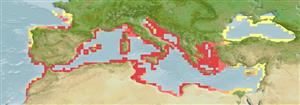>
Eupercaria/misc (Various families in series Eupercaria) >
Labridae (Wrasses)
Etymology: Symphodus: Greek, syn, symphysis = grown together + Greek, odous = teeth (Ref. 45335).
More on author: Linnaeus.
Environment: milieu / climate zone / depth range / distribution range
पारिस्थितिकी
समुद्री; खारा प्रवाल-भित्ति संयुक्त; गहराई सीमा 1 - 50 m (Ref. 121253). Subtropical; 47°N - 21°N, 11°W - 42°E
Eastern Atlantic: Spain to Morocco including the Mediterranean and Black Sea.
Length at first maturity / आकार / वज़न / Age
Maturity: Lm 11.7, range 12 - 15.2 cm
Max length : 44.0 cm SL पुल्लिंग / अलिंग; (Ref. 3397); common length : 25.0 cm SL पुल्लिंग / अलिंग; (Ref. 3397); अधिकतम सूचित उम्र: 15 वर्षो (Ref. 4742)
पृष्ठीय रीढ़ (सम्पूर्ण) : 15; पृष्ठीय सौफट रेज़ (सम्पूर्ण) : 11; गुदा कांटा: 3; ऐनल सौफट रेज़: 12.
Adults are found near rocks mainly in eel-grass beds, sometimes in salty lagoons. Often gregarious. Oviparous (Ref. 205). Nest of seaweed built and kept by male with one or more females spawning. Feed on sea urchins, ophiuroids, bivalves, shrimps and crabs (Ref. 4742). Rate of growth is slow (Ref. 4742). Undergoes sex reversal (Ref. 4742).
Oviparous (Ref. 205). One male makes a nest of seaweed for one or more females to spawn in (Ref. 4742). Undergoes sex reversal (Ref. 4742).
Quignard, J.-P. and A. Pras, 1986. Labridae. p. 919-942. In P.J.P. Whitehead, M.-L. Bauchot, J.-C. Hureau, J. Nielsen and E. Tortonese (eds.) Fishes of the north-eastern Atlantic and the Mediterranean. UNESCO, Paris. Vol. 2. (Ref. 4742)
IUCN Red List Status (Ref. 130435)
Threat to humans
Harmless
Human uses
मात्स्यिकी: निर्वाह मात्स्यिकी; आखेट मत्स्य: हां; जलजीवालय: व्यापारिक
साधन
Special reports
Download XML
इंटरनेट स्रोत
Estimates based on models
Preferred temperature (Ref.
123201): 16.3 - 21.4, mean 18.9 °C (based on 116 cells).
Phylogenetic diversity index (Ref.
82804): PD
50 = 0.5005 [Uniqueness, from 0.5 = low to 2.0 = high].
Bayesian length-weight: a=0.00933 (0.00783 - 0.01112), b=3.04 (3.00 - 3.08), in cm total length, based on LWR estimates for this species (Ref.
93245).
Trophic level (Ref.
69278): 3.3 ±0.3 se; based on diet studies.
लौटाव (Ref.
120179): माध्यम, न्यूनतम जनसंख्या दुगनी होने का समय 1.4 - 4.4 वर्ष। (K=0.25-0.89(?); tm=2-3; tmax=15).
Fishing Vulnerability (Ref.
59153): Moderate vulnerability (40 of 100).
Nutrients (Ref.
124155): Calcium = 27.3 [12.3, 58.4] mg/100g; Iron = 0.547 [0.298, 1.074] mg/100g; Protein = 19.5 [16.6, 21.7] %; Omega3 = 0.22 [0.13, 0.38] g/100g; Selenium = 14.8 [7.1, 28.4] μg/100g; VitaminA = 50.1 [14.3, 214.1] μg/100g; Zinc = 1.02 [0.67, 1.79] mg/100g (wet weight);
